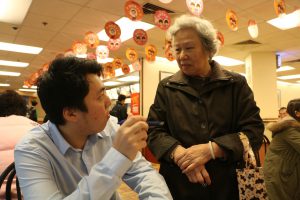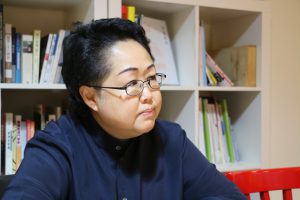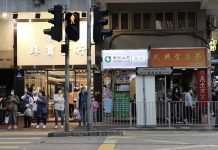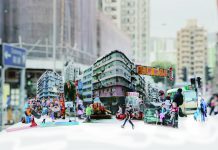As district councils have limited power to influence local affairs, residents are forming their own organisations
By Megan Leung & Rubie Fan
On a Sha Tin sidewalk, 22-year-old Wong Hok-lai fully extends his pull-up banner, sets up a folding table and some folding chairs. His mobile office is now complete and the rookie district councillor is ready to serve the community of Chung Tin, an area with a mixture of public housing estates, village houses and private residential developments.
Wong is one of several young newcomers who were elected in November’s district council polls and the youngest district councillor of the current term. Like other young people who contested the first elections after 2014’s Occupy Movement, Wong hopes to make a difference in local government through the district council. But getting elected into the district councils does not mean being able to change the established system.

Almost three months after his election, Wong still did not have an office in his constituency. Normally, the Housing Authority rents out offices to district councillors but because the previous district councillor did not move out immediately, Wong could only start applying to the Housing Authority for an office in January. He was finally allocated one in February.
But he does not regret the time he spent managing his makeshift mobile office. Although he had to stop when it rained, Wong thinks that being on the street also has its advantages. It allowed him to have more interaction with local residents and, for Wong, understanding residents’ needs is the key to building the community.
“It is less out of touch for me to have a booth on street,” he says.
The district councils have long been criticised for failing to properly consult the community on issues that affect members of the public. For instance, two rain shelters in Quarry Bay that cost a total of HK$210,000 were removed after being judged as useless and in the way. Yet, most people in the neighbourhood only found out about the construction plan after they were already built.
Wong says that to avoid such things happening, district councils should adopt a bottom-up approach and listen to residents’ opinions. “It is much more effective [for community participation] if they care about the issues,” says Wong. “After all, residents know best about their community’s problems.”
Before running for district councillor, Wong was a community officer for Shatin Community Network, which describes itself as a pragmatic localist democratic organisation. Wong’s role was like that of a middleman between the government and residents; for example, he lobbied the Transport Department to expand green mini bus services in the district.
After being elected as a district councillor, Wong is encouraged by his increased access to resources for community activities. And with his new title, officials and government bodies are more responsive to his requests for meetings and discussions.
However, these may be the only differences Wong has encountered before and after he became a district councillor. The district council is only an advisory body under the current political system and the ultimate decision-making power for district policies and projects lies in the hands of government departments.
“Ultimately, the constitutional power of the district council is limited. The power you have is to implement funding the government approved,” Wong says.
Local government has not always been so powerless. By the time of the handover in 1997, Hong Kong had three tiers of elected government, the district boards, the urban and regional councils and the Legislative Council. The urban and regional councils had greater policy-making power and financial autonomy than today’s district councils, and were responsible for cultural and leisure services and food and hygiene. But they were abolished in 1999 and their powers recentralised by the government.
The district boards were renamed as the district councils which remained consultation bodies advising the government on the well-being, infrastructure and environment of the various constituencies without any real administrative power.
In his 2014 Policy Address, Chief Executive Leung Chun-ying promised to give more power to the district councils, saying “district issues can be addressed at district level and local opportunities capitalised locally”. His government launched the Signature Project Scheme (SPS) in 2013 which granted HK$100 million for each district to implement projects in the community that were proposed, discussed by and agreed upon in the district council.
Ho Hau-cheung, who has been chairman of the Sha Tin District Council since 2012, says the sum being offered is nothing compared to other major infrastructure projects. Ho says he believes the scheme is a trial to see if district councils are capable of planning a HK$100 million project. “I believe that the SPS is a pilot for the district councils to make their own decisions,” says Ho.
However, he adds that the scheme does not mean district councils actually have more power because the real power is still in the hands of the Legislative Council, which can approve or reject the project. “When those problems reach the Legco, consultations are time-consuming, especially if there is filibustering,” says Ho.
The Sha Tin District Council has agreed to carry out two projects, the revitalisation of the Shing Mun River promenade and the construction of a five-a-side soccer pitch on a deck over the river. But the Legislative Council needs to review these two projects one by one.
Ho says that as the two projects cannot be combined, construction companies need to bid for them separately and cannot carry out the projects at the same time. This adds time and cost to the projects. “In the end, this will probably lead to [the projects going] over budget.”
Overall, Ho thinks the Signature Project Scheme is good for district councils and communities but he says the government needs to do more to increase the administrative power of the district councils. “How can district issues be addressed at district level when it holds such limited power?” asks Ho.
Chung Kim-wah, assistant professor in the department of Applied Social Sciences at the Hong Kong Polytechnic University, agrees the district councils are little more than talking shops due to their lack of decision-making power. According to Chung, this lack of authority is not their only shortcoming.
He points out the size of some of the 431 district council constituencies is very small, and may cover just a few blocks. This makes it difficult to reach a consensus within any district council, especially when the issue involves unwanted facilities like columbaria. “All kinds of reforms are quite difficult because of the interest of each small community which is trying to protect their own benefits,” explains Chung.
The problem is exacerbated when district councillors are seeking re-election, as they will strive to safeguard the interests of their potential voters. Chung says this tends to translate into handing out material benefits to the residents rather than engaging in long-term planning for the community, as the results of the latter may not be seen before the next election.
Although Chung agrees the lack of real authority is a problem for the district councils, he spots a potential pitfall in granting the local bodies more power without stepping up supervision. He points out the pro-establishment camp dominates the district councils and as he sees it, “they [the pro-establishment camp] are trying to loosen up regulations and guidelines to get as many benefits as possible.”
More resources for the district council could favour the pro-establishment camp and allow them to stabilise their support, he adds.
Still, there is little sign of any major reform to the district councils in the foreseeable future. However, the former chairperson of the Wan Chai District Council, Ada Wong Ying-kay, believes that even under the existing system, there is still room to imagine a better district council and better community organisation.

Wong served as the district councillor for the Broadwood constituency between 2000 and 2007 and chaired the Wan Chai District Council between 2004 and 2007. Her leadership of the body was hailed as a success.
During Wong’s term, Wan Chai established Hong Kong’s first dog park, a move that came about after Wong mobilised residents’ awareness of the issue and worked with various government departments to make it happen.
Wong has always believed in encouraging social innovation in a district to raise residents’ sense of belonging in their community. Despite the limitations and problems of the district councils, she thinks there are also many opportunities for residents to think up new and creative solutions to problems.
She cites an example in the Central and Western District, where young people who were defeated in the district council election set up their own shadow district council. “They are self-empowered and they think they can make a change,” Wong says. “Self-empowerment means getting together and spending time discussing public issues.”
Although she is no longer a district councillor, Wong remains active in community affairs. She set up the Central Market Concern Group with friends to raise public concern over the redevelopment of the Bauhaus-style Central Market building into a shopping mall. “I am just a normal citizen, but I still care about my home and community. I think that if I don’t speak out, I will lose the chance to influence the district council, ” Wong says.
Whether residents can be self-empowered depends on their awareness of district issues, and their sense of belonging to the community. Chan Kin-man, professor of sociology at the Chinese University of Hong Kong, says such engagement in local issues is difficult to achieve in Hong Kong as people are often disconnected from their communities.
Chan says people in Hong Kong are only connected through shopping malls. Relationships are between customers and shop owners, and the customers do not interact with each other, nor do they feel they belong to the same community.
According to Chan, local communities in Hong Kong are becoming “bedroom communities” where the only time people spend in their communities is when they go home late after work.
“They just go back and sleep and will leave early in the morning for work. So why should they care about the community?” Chan asks. Hong Kong, he says, is now such a commercial city and pushes development to such extremes, that communities are destroyed.
To rebuild more closely connected communities in Hong Kong, a number of community initiated independent organisations have sprung up. They hope to use a bottom-up approach to organise community activities to build networks within the districts.
The Community Citizen Charter (CCC), set up in the aftermath of the Umbrella Movement, is one such organisation. Group spokesperson Karena Tang Yuen-sum says it hopes to gather passionate people from the community to volunteer to solve local problems and organise events.
Although the group participated in the district council elections last year, Tang thinks residents should not solely rely on the district councils to solve their problems. “When residents are able to use their own resources to help the community, this in fact increases their ownership and sense of belonging to the community,” says Tang.
One of the group’s most popular activities is book-swap festivals held in different districts in Hong Kong. So far more than a dozen have been organised and Tang says they not only help to build connections and ties between residents but are also a chance to raise their awareness of community affairs.
For example, when the group held a book-swap festival in the northeast New Territories, they also hosted a small exhibition introducing the North East New Territories New Development Areas plan for the participants and encouraged them to discuss the issue.
“This makes them realise that they can also be part of the issue, they are able to express their opinions,” says Tang. “A real community can be formed when residents have shared belief, interests and a common identity, and are willing to gather to fight for something continuously.”
Edited by Emily Man













































